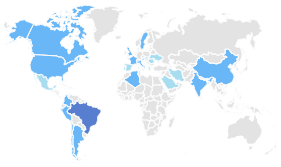Energy Recover in Sweden: a Case Study
Resumo
Sweden has reached prominent figures both in waste management and reducing greenhouse gases emissions. Less than 1 percent of its municipal solid waste is landfilled, and the other 99 percent is harnessed by either recycling or producing energy. It helped the country’s decarbonization, as its GDP raised 75% while its emission decreased 26% during the period 1990-2016. This is why the Sweden is a benchmarking either regarding waste management and economy decarbonization. This paper had the objective to identify key success factors that could inspire better practices in regulation and public policies regarding the energy and material recovering from municipal solid waste. To accomplish the goal it was held nine incineration plants technical visits, as well 19 Sweden experts were interviewed. It was delivered a overview of the stage of excellence of Sweden regarding waste and energy policies and 12 success factors were outlined. The key factors can be reunited in four groups: (a) holistic policy approach regarding diverse public demands; (b) integration of recycling and energy recovery from waste; (c) use of economic instruments such as taxes and tariffs in order to discourage harmful and incentive positive practices; (d) municipality’s autonomy with economic and operational capacity. The key factors can also be useful lessons to decision and opinion makers of other countries to formulate strategies that can contribute to improve performance regarding proper waste destination and decarbonization of the economy.
Key-words: Waste Management, Decarbonization, Sweden, Energy Recovering, Waste-to-Energy, Low Carbon Economy.
Texto completo:
PDFReferências
Andersson, K. 2015. Bioenergy the Swedish experience: How bioenergy became the largest energy source in Sweden Ark-Tryckarn, Jönköping.
Avfallsverige. Swedish waste management 2017. Available at: . Retrieved in: June 03, 2017.
____. Towards a greener future with Swedish Waste-to-energy The world’s best example, 2009. Available at: . Retrieved in: May 13, 2017.
____. Waste-to-Energy in Sweden – suppliers of sustainable solutions. Available at: . Retrieved in: March 16, 2017.
Barbalace, R. C. The History of waste. Environmental Chemistry. 2003. Available at: . Retrieved in: January 15, 2017.
Bevanger, L. First-world problem? Norway and Sweden battle over who gets to burn waste, DW, 23/11/2015. Available at: . Retrieved in: January 15, 2017.
Blokland, M. W. 2010. Benchmarking water services delivery. In: M. Kurian and P. McCarney (eds). Peri-urban water and sanitation services: policy, planning and method. New York (USA): Springer Verlag,.
Clark, J. 2003. The Burning Issue: historical reflections on municipal waste incineration AHRB Research Centre for Environmental History. Available at: . Retrieved in: April 29, 2017.
Corvellec, H.; Bramryd, T.; Hultman, J. 2011. The business model of Swedish municipal waste management companies, Lund University, May 2011.
EPE – Brazilian Research Energy Company, 2008. Ten-year plan of energy expansion. 2008-2017. Rio de Janeiro; Brasília: EPE; MME, 07 de novembro de 2008. Available at: . Retrieved in: November 20, 2018.
EPA – Environmental Protection Agency, 2016. Wastes – Non-Hazardous Waste – Municipal Solid Waste. Last updated on 29/03/2016. Available at: . Retrieved in: March 29, 2016.
Ericsson, K., 2009. Introduction and development of the Swedish District Heating systems: critical factors and lessons learned Lund University, March 2009. Available at: . Retrieved in: June 12, 2016.
EP – European Parliament, 2016. Closing the loop: New circular economy package. January. Available at: . Retrieved in: October 18, 2017.
EUR-LEX - European Union. Directive 2009/28/EC of the European Parliament and of the Council of 23 April 2009 on the promotion of the use of energy from renewable sources and amending and subsequently repealing Directives 2001/77/EC and 2003/30/EC /77/CE e 2003/30/CE. Available at: . Retrieved in: October 13, 2017.
(dataset) EUROSTAT. Urban Europé: statistics on cities, towns and suburbs, 2016. Available at: . Retrieved in: July 10, 2018.
____. Environment: cities and greater cities table, última atualização 20 de março de 2017. Available at: . Retrieved in: January 24, 2017.
____. Greenhouse gas emissions. Available at: . Retrieved in: December 13, 2018.
____. Municipal waste statistics. Available at: . Retrieved in: July 10, 2017.
DOI: http://dx.doi.org/10.17648/calibre.v5.1337
Apontamentos
- Não há apontamentos.
Direitos autorais 2020 Marco Tsuyama
Indexadores, Diretórios, Bases de Dados e Registros (Abstracted and Indexed in):

CALIBRE - Revista Brasiliense de Engenharia e Física Aplicada
ISSN Eletrônico: 2526-4192































